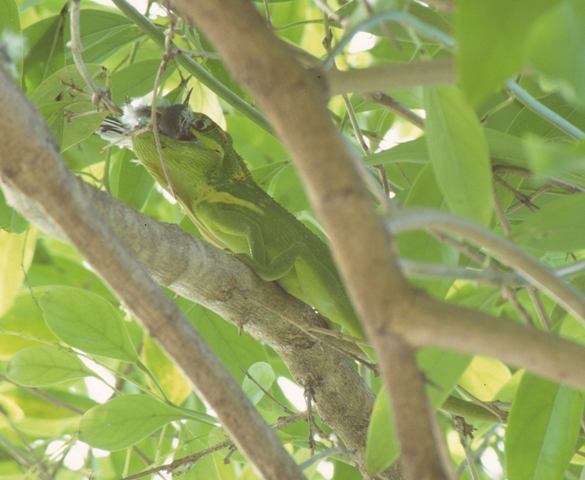I originally requested this on Carnivoraforum, but it's nice to see this here.
Will say that it is quite difficult to find reliable weights and measurements for small lizards like these. There's some interesting information posted on weights for both lizards by Ceratodromeus in a few threads on Carnivoraforum.
"Size and mass data revealed strong differences in
sexual dimorphism between the two populations.
Although male and female C. c. auriceps did not differ
in size or mass (N1 = 13, N2 = 6; SVL: males = 92.3 ±
0.9 mm, females = 88.0 ± 2.1 mm, U = 19.5, P = 0.085;
mass: males = 30.5 ± 1.0 g, females = 29.7 ± 1.5 g,
U = 33.5, P = 0.629), C. c. fuscus males and females differed
significantly on both measures (N1 = 12, N2 = 10;
SVL: males = 107.5 ± 1.6 mm, females = 92.0 ±
2.1 mm, U = 10, P = 0.001; mass: males = 54.8 ± 2.5 g,
females = 30.6 ± 2.9 g, U = 5.5, P = 0.0003). Likewise,
males from the two populations differed significantly
both in size and mass (N1 = 13, N2 = 12; SVL: U = 1,
P = 0.0001; mass: U = 0, P = 0.0001) but females
differed on neither measure (N1 = 6, N2 = 10; SVL:
U = 21.5, P = 0.355; mass: U = 28.5, P = 0.870)"
www.faculty.ucr.edu/~ybrandt/pdf/Macedonia_etal2002.pdf
Cited articles
*The knight anole(anolis equestris) in Florida(Campasano et.al(2008))
**Comments on density and diet of the giant anole(Anolis equestris) (Dalrymple 1980)

Cite:
Nicholson, Kirsten E., and Paul M. Richards. "Home-range size and overlap within an introduced population of the Cuban Knight Anole, Anolis equestris (Squamata: Iguanidae)." Phyllomedusa: Journal of Herpetology 10.1 (2011): 65-73.
Credit to Ceratodromeus for originally finding those.
It does seem like the anole might have a good size advantage, but parity is also possible if we go by the source of weights given on the second link.
They are both incredibly aggressive and territorial animals, and I don't think that one would have an aggression advantage over the other.
A violent fight between two knight anoles (look at the impressive amount of damage inflicted on the loser's head):
[flash=250,250]http://www.youtube.com/watch?v=Ol2XYtWrhf0[/flash]
An interesting account of a knight anole taking a blue-gray gnatcatcher (
Polioptila caerulea).
 www.anoleannals.org/2012/02/26/knight-anole-eating-a-bird/
www.anoleannals.org/2012/02/26/knight-anole-eating-a-bird/Now on collared lizards:
In captivity if two males are placed in the same cage they will fight to the death. en.wikipedia.org/wiki/Common_collared_lizard"
Like other collared lizards this lizard is territorial and aggressive to other males. It does not hesitate to bite when captured and it can easily draw blood with its powerful jaws."
www.reptilesofaz.org/Lizards-Subpages/h-c-bicinctores.html"
Collared lizards must be closely monitored during breeding season, as males can be very aggressive. Mating typically consists of the male grasping the female by the neck, which can result in superficial lacerations. It is important to use similar-sized individuals and monitor the animals closely for bite marks or weight loss. In more severe cases, the male may attack and even cannibalize a smaller female."
www.reptilesmagazine.com/Lizards/Breeding-Lizards/Breeding-the-Collared-Lizard/Here's a collared lizard fight:
[flash=400,400]http://www.youtube.com/watch?v=10s-ekJK2Vw[/flash]
Note the very quick reflexes and movements shown with the collared lizards in this intraspecific fight. The common collared lizard is actually amongst the fastest lizards lizards, running up to 16 mph (I know that this is on their hind legs, but there's still enough evidence (including the video shown above) to show that the common lizards are still very quick and agile on all fours as well. I easily imagine the collared lizard being the faster and more agile one here by far, which can prove to be effective in such a fight due to the likelihood of striking before vice versa.
Here's a skull comparison (collared lizard top, knight anole middle and bottom):



I can't say that I know the length of their skulls very much (which would be interesting to know purely for the interest of knowing who has the reach advantage), but they do both have very impressive weaponry as shown by the amount of damage that they can inflict on each other during intraspecific conflict. I will say, however, that it's interesting to note how important bite force seems to be in intraspecific conflict with collared lizards. The victor of the fights are often determined by how much bite force an individual collared lizard has in a fight, or how impressive their weaponry is in comparison to the opponent they face, even against a larger opponent. Based on the shape of the head and the size advantage it normally holds, the knight anole may very well have the reach advantage but I don't think that's a representation for who has the better bite overall.
I think it's hard to say judging from how aggressive/combative both are, but the end result would probably be the anole taking the win slightly at average weights but the collared lizard winning at parity. I imagine the anole having a fair bit of a size advantage to overcome the collared lizard normally, but the collared lizard defeating the anole through the slightly more robust build it has, the speed/agility advantage and the amount of aggression it has that a knight anole also would have. Overall, a male collared lizard would defeat a male knight anole (judging by the info that Ceratodromeus has given, I think it would stand a good chance even at average weights) although it would be an incredibly close fight.
The male collared lizard would win against a female knight anole as well.
A male knight anole would destroy (maybe even predate on) a female collared lizard because female collared lizards won't and can't fight, and a female knight anole would most likely win against a female collared lizard too.
Overall, collared lizard would win this 6/10.